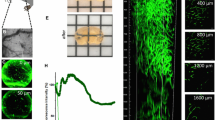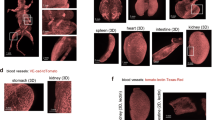Abstract
Application of tissue clearing techniques on human brain tumors is still limited. This study was to investigate the application of CUBIC on 3D pathological studies of human brain tumors. Brain tumor specimens derived from 21 patients were cleared with CUBIC. Immunostaining was conducted on cleared specimens to label astrocytes, microglia and microvessels, respectively. All tumor specimens achieved transparency after clearing. Immunostaining and CUBIC are well compatible in a variety of human brain tumors. Spatial morphologies of microvessels, astrocytes and microglia of tumors were clearly visualized in 3D, and their 3D morphological parameters were easily quantified. By comparing the quantitative morphological parameters of microvessels among brain tumors of different malignancy, we found that mean vascular diameter was positively correlated with tumor malignancy. Our study demonstrates that CUBIC can be successfully applied to 3D pathological studies of various human brain tumors, and 3D studies of human brain tumors hold great promise in helping us better understand brain tumor pathology in the future.




Similar content being viewed by others
Data availability
Data underlying the results presented in this paper may be obtained from the authors upon reasonable request.
References
Louis DN, Perry A, Reifenberger G et al (2016) The 2016 world health organization classification of tumors of the central nervous system: a summary. Acta Neuropathol 131:803–820
Sun L, Wang D, Zubovits JT et al (2009) An improved processing method for breast whole-mount serial sections for three-dimensional histopathology imaging. Am J Clin Pathol 131:383–392
Booth ME, Treanor D, Roberts N et al (2015) Three-dimensional reconstruction of ductal carcinoma in situ with virtual slides. Histopathology 66:966–973
Richardson DS, Lichtman JW (2015) Clarifying Tissue Clearing. Cell 162:246–257
Ueda HR, Erturk A, Chung K et al (2020) Tissue clearing and its applications in neuroscience. Nat Rev Neurosci 21:61–79
Erturk A, Becker K, Jahrling N et al (2012) Three-dimensional imaging of solvent-cleared organs using 3DISCO. Nat Protoc 7:1983–1995
Susaki EA, Tainaka K, Perrin D et al (2015) Advanced CUBIC protocols for whole-brain and whole-body clearing and imaging. Nat Protoc 10:1709–1727
Chung K, Wallace J, Kim SY et al (2013) Structural and molecular interrogation of intact biological systems. Nature 497:332–337
Wan P, Zhu J, Xu J et al (2018) Evaluation of seven optical clearing methods in mouse brain. Neurophotonics 5:035007
Lloyd-Lewis B, Davis FM, Harris OB et al (2016) Imaging the mammary gland and mammary tumours in 3D: optical tissue clearing and immunofluorescence methods. Breast Cancer Res 18:127
Tainaka K, Kubota SI, Suyama TQ et al (2014) Whole-body imaging with single-cell resolution by tissue decolorization. Cell 159:911–924
Xu Y, Li P, Wang M et al (2019) Imaging the brain in 3D using a combination of CUBIC and immunofluorescence staining. Biomed Opt Express 10:2141–2149
Liang H, Wang H, Wang S et al (2018) 3D imaging of PSD-95 in the mouse brain using the advanced CUBIC method. Mol Brain 11:50
Louis D, Perry A, Wesseling P et al (2021) The 2021 who classification of tumors of the central nervous system: a summary. Neuro Oncol 23:1231–1251
Boulagnon-Rombi C, Fleury C, Fichel C et al (2017) Immunohistochemical Approach to the Differential Diagnosis of Meningiomas and Their Mimics. J Neuropathol Exp Neurol 76:289–298
Deb P, Boruah D, Dutta V (2012) Morphometric study of microvessels in primary CNS tumors and its correlation with tumor types and grade. Microvasc Res 84:34–43
Karperien A, Ahammer H, Jelinek HF (2013) Quantitating the subtleties of microglial morphology with fractal analysis. Front Cell Neurosci 7:3
Baslan T, Hicks J (2017) Unravelling biology and shifting paradigms in cancer with single-cell sequencing. Nat Rev Cancer 17:557–569
P B, M P, I F et al. (2003) Vascular patterns in glioblastoma influence clinical outcome and associate with variable expression of angiogenic proteins: evidence for distinct angiogenic subtypes. Brain pathology (Zurich, Switzerland) 13: 133–143
Komori T (2022) Grading of adult diffuse gliomas according to the 2021 WHO classification of tumors of the central nervous system. Lab Invest 102:126–133
Gomez-Gaviro MV, Sanderson D, Ripoll J, Desco M. (2020) Biomedical applications of tissue clearing and three-dimensional imaging in health and disease. iScience; 23: 101432.
Almagro J, Messal HA, Zaw Thin M et al (2021) Tissue clearing to examine tumour complexity in three dimensions. Nature Rev Cancer 21:718–730
Tian T, Yang Z, Li X (2020) Tissue clearing technique: recent progress and biomedical applications. J Anat 238:489–507
Ando K, Laborde Q, Lazar A et al (2014) Inside Alzheimer brain with CLARITY: senile plaques, neurofibrillary tangles and axons in 3-D. Acta Neuropathol 128:457–459
Liu AK, Hurry ME, Ng OT et al (2016) Bringing CLARITY to the human brain: visualization of Lewy pathology in three dimensions. Neuropathol Appl Neurobiol 42:573–587
Lagerweij T, Dusoswa SA, Negrean A et al (2017) Optical clearing and fluorescence deep-tissue imaging for 3D quantitative analysis of the brain tumor microenvironment. Angiogenesis 20:533–546
Zhu X, Huang L, Zheng Y et al (2019) Ultrafast optical clearing method for three-dimensional imaging with cellular resolution. Proc Nati Acad Sci US Am 116:11480–11489
Susaki EA, Shimizu C, Kuno A et al (2020) Versatile whole-organ/body staining and imaging based on electrolyte-gel properties of biological tissues. Nat Commun 11:1982
Jing D, Zhang S, Luo W et al (2018) Tissue clearing of both hard and soft tissue organs with the PEGASOS method. Cell Res 28:803–818
Pan C, Cai R, Quacquarelli FP et al (2016) Shrinkage-mediated imaging of entire organs and organisms using uDISCO. Nat Methods 13:859–867
Gleave JA, Lerch JP, Henkelman RM, Nieman BJ (2013) A method for 3D immunostaining and optical imaging of the mouse brain demonstrated in neural progenitor cells. PLoS ONE 8:e72039
Li J, Czajkowsky DM, Li X, Shao Z (2015) Fast immuno-labeling by electrophoretically driven infiltration for intact tissue imaging. Sci Rep 5:10640
Ku T, Guan W, Evans NB et al (2020) Elasticizing tissues for reversible shape transformation and accelerated molecular labeling. Nat Methods 17:609–613
Boruah D, Deb P, Srinivas V, Mani NS (2014) Morphometric study of nuclei and microvessels in gliomas and its correlation with grades. Microvasc Res 93:52–61
Fortin D, Cairncross G, Hammond RJN (1999) Oligodendroglioma: an appraisal of recent data pertaining to diagnosis and treatment. Neurosurgery 45:1279–1291
Andersen B, Faust Akl C, Wheeler M et al (2021) Glial and myeloid heterogeneity in the brain tumour microenvironment. Nat Rev Cancer 21:786–802
Guo H, Kang H, Tong H et al (2019) Microvascular characteristics of lower-grade diffuse gliomas: investigating vessel size imaging for differentiating grades and subtypes. Eur Radiol 29:1893–1902
Acknowledgements
We thank Dr. Jianping Liu, Zongguo Pang and Wangyan Zhang from Pathology Department of West China Hospital for their contribution in the diagnosis of brain tumors.
Funding
This study received grands from 135 Project of Outstanding Development of West China Hospital, Sichuan University (ZY2017307).
Author information
Authors and Affiliations
Corresponding authors
Ethics declarations
Conflict of interest
The authors declare on conflicts of interest relating to this study.
Ethical statement
Written informed consents about using tumor specimens for this study were obtained from all patients or their legal guardians. The study was approved by West China Hospital of Sichuan University Biomedical Research Ethics Committee.
Additional information
Publisher's Note
Springer Nature remains neutral with regard to jurisdictional claims in published maps and institutional affiliations.
Supplementary Information
Below is the link to the electronic supplementary material.
Rights and permissions
Springer Nature or its licensor (e.g. a society or other partner) holds exclusive rights to this article under a publishing agreement with the author(s) or other rightsholder(s); author self-archiving of the accepted manuscript version of this article is solely governed by the terms of such publishing agreement and applicable law.
About this article
Cite this article
Xu, Y., He, Q., Wang, M. et al. Three-dimensional visualization of human brain tumors using the CUBIC technique. Brain Tumor Pathol 40, 4–14 (2023). https://doi.org/10.1007/s10014-022-00445-2
Received:
Accepted:
Published:
Issue Date:
DOI: https://doi.org/10.1007/s10014-022-00445-2




